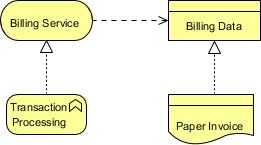The realization relationship indicates that an entity plays a critical role in the creation, achievement, sustenance, or operation of a more abstract entity.. The example below illustrates two ways to use the realization relationship. A Transaction Processing function realizes a Billing Service; the Billing Data object is realized by the representation Paper Invoice.

- The realization relationship indicates that more abstract entities (“what” or “logical”) are realized by means of more tangible entities (“how” or “physical”).
- The realization relationship is used to model run-time realization
- Eor example: A business process realizes a business service, and that a data object realizes a business object, an artifact realizes an application component, or a core element realizes a motivation element.
![]()
The usual interpretation of a realization relationship is that the whole or part of the source element realizes the whole of the target element.
Related Articles: